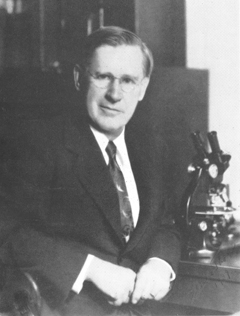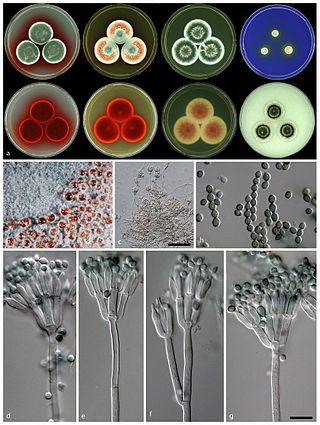
Penicillium is a genus of ascomycetous fungi that is part of the mycobiome of many species and is of major importance in the natural environment, in food spoilage, and in food and drug production.
Penicillium bilaiae is a species of native soil fungus that can be used as a PGPM. R. Kucey first identified that organic acids excreted by the microorganism can solubilize soil-bound phosphate. The organism can live in symbiosis with several plant species by enhancing phosphate uptake by the root structure while feeding off plant waste products. Native soil populations are often low and can be increased by application as an agricultural inoculant.

The Trichocomaceae are a family of fungi in the order Eurotiales. Taxa are saprobes with aggressive colonization strategies, adaptable to extreme environmental conditions. Family members are cosmopolitan in distribution, ubiquitous in soil, and common associates of decaying plant and food material.

Penicillium roqueforti is a common saprotrophic fungus in the genus Penicillium. Widespread in nature, it can be isolated from soil, decaying organic matter, and plants.

Antarctica is one of the most physically and chemically extreme terrestrial environments to be inhabited by lifeforms. The largest plants are mosses, and the largest animals that do not leave the continent are a few species of insects.

Charles Thom was an American microbiologist and mycologist. Born and raised in Illinois, he received his PhD from the University of Missouri, the first such degree awarded by that institution. He studied the microbiology of dairy products and soil fungi, and in particular researched the genera Aspergillus and Penicillium. His work influenced the establishment of standards for food handling and processing in the USA. He pioneered the use of culture media to grow microorganisms, and, with food chemist James N. Currie, developed a process to mass-produce citric acid using Aspergillus. Thom played an important role in the development of penicillin in World War II.

Botryodiplodin is an antibiotic mycotoxin produced by Penicillium.
Penicillium albidum is an anamorph fungus species of the genus of Penicillium which was isolated from volcanic soils in the south of Chile. Penicillium albidum produces the antibiotic Albidin.

Talaromyces is a genus of fungi in the family Trichocomaceae. Described in 1955 by American mycologist Chester Ray Benjamin, species in the genus form soft, cottony fruit bodies (ascocarps) with cell walls made of tightly interwoven hyphae. The fruit bodies are often yellowish or are surrounded by yellowish granules. A 2008 estimate placed 42 species in the genus, but several new species have since been described.
Penicillium vanoranjei is an orange-colored fungus first described in 2013 from specimens collected in Tunisia. It was named after the Prince of Orange Willem-Alexander to commemorate his coronation as King of the Netherlands.
Penicillium caerulescens is a fungus species of the genus of Penicillium which was isolated from soil.
Penicillium calidicanium is a fungus species of the genus of Penicillium which was isolated from soil in Taiwan.
Penicillium euglaucum is a species of the genus of Penicillium which was isolated from soil in Argentina.
Penicillium giganteum is a species of the genus of Penicillium which was isolated from soil.
Penicillium kananaskense is an anamorph species of the genus of Penicillium which was isolated from soil of a forest in Alberta in Canada.
Penicillium lacus-sarmientei is an anamorph species of the genus of Penicillium which was isolated from soil of the shores of the Lake Sarmiento in the Chilean Tierra del Fuego.
Penicillium pimiteouiense is a species of fungus in the genus Penicillium which was isolated from sandy beach soil from the Penang Island in Peninsular Malaysia.
Penicillium purpurescens is a species of fungus in the genus Penicillium which was isolated from soil in Canada. This species is similar to Penicillium glabrum. Penicillium purpurescens produces hadacidin.

Penicillium spinulosum is a non-branched, fast-growing fungus with a swelling at the terminal of the stipe (vesiculate) in the genus Penicillium. P. spinulosum is able to grow and reproduce in environment with low temperature and low water availability, and is known to be acidotolerant. P. spinulosum is ubiquitously distributed, and can often be isolated from soil. Each individual strain of P. spinulosum differs from others in their colony morphology, including colony texture, amount of sporulation and roughness of conidia and conidiophores.







